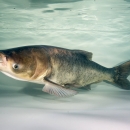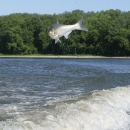We investigated the spatial and temporal distribution of Bighead Carp and Silver Carp (hereafter Carp) in the lower Red River basin of Arkansas. Our study objectives were: 1) determine the spatial and temporal extent of Bighead and Silver Carp in the Red River basin of Arkansas; 2) determine habitat associations of large river fish assemblages; and 3) summarize the demographics of Bighead and Silver Carp. We sampled 67 reaches in the lower Red River and its major tributaries for juvenile Carp and other small-bodied fishes (24 of the reaches were in the Arkansas portion of the Red River). We conducted repeated surveys in these reaches where the reaches were sampled 2-3 times over approximately 2 years representing 242 surveys (95 surveys in Arkansas). We completed adult Carp and native fish assemblage sampling across 61 reaches (22 reaches in Arkansas) where we also repeated surveys at these locations (245 total surveys, 100 surveys completed in Arkansas during the reporting period). We captured the most large-bodied fishes (including Carp) using gillnets and electrofishing, whereas fyke nets and seine hauls collected mainly smaller-bodied fishes. Hoop nets captured fewer fishes when compared to other gear types. We sampled 120,072 fishes, comprising 70 species and 41 genera, from the mainstem Red River in Arkansas. We used data associated with the entire catchment (including OK and TX data) to model the occupancy of adult fishes including both carp species. Carp tended to occupy reaches with the presence of slackwater habitat, that were deeper and narrower (lower habitat complexity), with higher discharge conditions, and were positively associated with chlorophyll-a concentrations. Adult and juvenile assemblage structure structure
Something temporarily or permanently constructed, built, or placed; and constructed of natural or manufactured parts including, but not limited to, a building, shed, cabin, porch, bridge, walkway, stair steps, sign, landing, platform, dock, rack, fence, telecommunication device, antennae, fish cleaning table, satellite dish/mount, or well head.
Learn more about structure varied with reach scale attributes with notable differences among some taxonomically similar species. No carp under the age of 3 were sampled in the catchment. Bighead Carp and Silver Carp in the Red River catchment appear to live longer and grow larger than other populations. Silver Carp and Bighead Carp in the lower Red River had a theoretical maximum length (L_∞) of 920 and 1348-mm TL, respectively. The oldest sampled Silver Carp and Bighead Carp were age 14 and 17, respectively. Bighead Carp growth was positively associated with warmer air temperatures and negatively associated with discharge variability. Similarly, Silver Carp growth was positively associated with the warm air temperature and negatively associated with discharge variability. However, Silver Carp growth was also positively related to high discharge conditions and the variability of air temperature. Silver Carp annual mortality was relatively low and recruitment into the population appeared steady. It appears that Carp are likely coming from another catchment, have only limited or periodic successful reproduction in the study area, or spawn downriver in LA. Continued monitoring for reproductive success would be helpful. Moreover, if the goal is to greatly reduce or eliminate carp, then strategies to prevent further immigration would be ideal before reproduction occurs or becomes more successful. Targeted removal may then be useful for reducing numbers already in the catchment; however, there are also oxbow lakes that contain carp but appear only connected to the river during major floods (i.e., possible source locations).
Publication date
Type of document
Report
Species
FWS Focus
FWS Focus
Ecosystem


